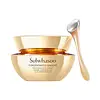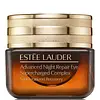What's inside
What's inside
 Key Ingredients
Key Ingredients

 Benefits
Benefits

 Concerns
Concerns

 Ingredients Side-by-side
Ingredients Side-by-side

Water
Skin ConditioningButylene Glycol
HumectantSqualane
EmollientGlycerin
HumectantPropanediol
SolventBehenyl Alcohol
EmollientDiisostearyl Malate
EmollientDimethicone
EmollientPolyglyceryl-3 Methylglucose Distearate
EmulsifyingHydrogenated Castor Oil Isostearate
Skin ConditioningPhytosteryl Isostearyl Dimer Dilinoleate
EmollientButyrospermum Parkii Butter
Skin ConditioningPhytosteryl/Behenyl/Octyldodecyl Lauroyl Glutamate
Skin ConditioningStearic Acid
CleansingGlyceryl Stearate
EmollientPEG-100 Stearate
1,2-Hexanediol
Skin ConditioningMethoxy PEG-114/Polyepsilon Caprolactone
BufferingPolyacrylate-13
Phenoxyethanol
PreservativePanax Ginseng Root Extract
EmollientPolyisobutene
Hydrolyzed Ginseng Saponins
Skin ConditioningCaffeine
Skin ConditioningHoney
HumectantAlcohol
AntimicrobialParfum
MaskingNelumbo Nucifera Flower Extract
Skin ConditioningPolygonatum Officinale Rhizome/Root Extract
Skin ConditioningRehmannia Glutinosa Root Extract
Skin ConditioningPaeonia Albiflora Root Extract
Skin ConditioningLilium Candidum Bulb Extract
Skin ConditioningEthylhexylglycerin
Skin ConditioningPolysorbate 20
EmulsifyingSorbitan Isostearate
EmulsifyingDisodium EDTA
Sodium Polyacrylate
AbsorbentTheobroma Cacao Extract
Skin ConditioningDextrin
AbsorbentGlycyrrhiza Uralensis Root Extract
Skin ConditioningAlpha-Isomethyl Ionone
PerfumingLimonene
PerfumingHydrogenated Lecithin
EmulsifyingLinalool
PerfumingPanax Ginseng Flower Extract
AntioxidantHydroxyisohexyl 3-Cyclohexene Carboxaldehyde
MaskingHexyl Cinnamal
PerfumingPhytosphingosine
Skin ConditioningSodium Polyaspartate
HumectantTocopherol
AntioxidantSodium Methyl Stearoyl Taurate
CleansingWater, Butylene Glycol, Squalane, Glycerin, Propanediol, Behenyl Alcohol, Diisostearyl Malate, Dimethicone, Polyglyceryl-3 Methylglucose Distearate, Hydrogenated Castor Oil Isostearate, Phytosteryl Isostearyl Dimer Dilinoleate, Butyrospermum Parkii Butter, Phytosteryl/Behenyl/Octyldodecyl Lauroyl Glutamate, Stearic Acid, Glyceryl Stearate, PEG-100 Stearate, 1,2-Hexanediol, Methoxy PEG-114/Polyepsilon Caprolactone, Polyacrylate-13, Phenoxyethanol, Panax Ginseng Root Extract, Polyisobutene, Hydrolyzed Ginseng Saponins, Caffeine, Honey, Alcohol, Parfum, Nelumbo Nucifera Flower Extract, Polygonatum Officinale Rhizome/Root Extract, Rehmannia Glutinosa Root Extract, Paeonia Albiflora Root Extract, Lilium Candidum Bulb Extract, Ethylhexylglycerin, Polysorbate 20, Sorbitan Isostearate, Disodium EDTA, Sodium Polyacrylate, Theobroma Cacao Extract, Dextrin, Glycyrrhiza Uralensis Root Extract, Alpha-Isomethyl Ionone, Limonene, Hydrogenated Lecithin, Linalool, Panax Ginseng Flower Extract, Hydroxyisohexyl 3-Cyclohexene Carboxaldehyde, Hexyl Cinnamal, Phytosphingosine, Sodium Polyaspartate, Tocopherol, Sodium Methyl Stearoyl Taurate
Methyl Trimethicone
Skin ConditioningWater
Skin ConditioningBifida Ferment Lysate
Skin ConditioningDimethicone
EmollientDimethicone/Vinyl Dimethicone Crosspolymer
Skin ConditioningPropanediol
SolventSucrose
HumectantPetrolatum
EmollientPolysorbate 40
EmulsifyingTrehalose
HumectantAlgae Extract
EmollientMorus Bombycis Root Extract
Skin ConditioningScutellaria Baicalensis Root Extract
AstringentLactobacillus Ferment
Skin ConditioningTriticum Vulgare Germ Extract
Skin ConditioningAcrylamide/Sodium Acryloyldimethyltaurate Copolymer
Emulsion StabilisingBetula Alba Bud Extract
Skin ConditioningHydrolyzed Algin
Poria Cocos Sclerotium Extract
AstringentJojoba Alcohol
EmollientEthylhexylglycerin
Skin ConditioningGlycine Soja Seed Extract
Skin ConditioningIsopropyl Jojobate
EmollientJojoba Esters
EmollientIsohexadecane
EmollientYeast Extract
Skin ConditioningHydrogenated Lecithin
EmulsifyingHordeum Vulgare Extract
EmollientPEG/PPG-18/18 Dimethicone
EmulsifyingCholesterol
EmollientAnthemis Nobilis Flower Extract
MaskingTocopheryl Acetate
AntioxidantSodium Rna
Skin ConditioningCaffeine
Skin ConditioningPolysorbate 80
EmulsifyingCaprylyl Glycol
EmollientPhytosphingosine
Skin ConditioningSqualane
EmollientPotassium Sulfate
Sodium Hyaluronate
HumectantAcrylates/C10-30 Alkyl Acrylate Crosspolymer
Emulsion StabilisingTripeptide-32
Skin ConditioningButylene Glycol
HumectantTromethamine
BufferingDisodium EDTA
BHT
AntioxidantPhenoxyethanol
PreservativeIron Oxides
Methyl Trimethicone, Water, Bifida Ferment Lysate, Dimethicone, Dimethicone/Vinyl Dimethicone Crosspolymer, Propanediol, Sucrose, Petrolatum, Polysorbate 40, Trehalose, Algae Extract, Morus Bombycis Root Extract, Scutellaria Baicalensis Root Extract, Lactobacillus Ferment, Triticum Vulgare Germ Extract, Acrylamide/Sodium Acryloyldimethyltaurate Copolymer, Betula Alba Bud Extract, Hydrolyzed Algin, Poria Cocos Sclerotium Extract, Jojoba Alcohol, Ethylhexylglycerin, Glycine Soja Seed Extract, Isopropyl Jojobate, Jojoba Esters, Isohexadecane, Yeast Extract, Hydrogenated Lecithin, Hordeum Vulgare Extract, PEG/PPG-18/18 Dimethicone, Cholesterol, Anthemis Nobilis Flower Extract, Tocopheryl Acetate, Sodium Rna, Caffeine, Polysorbate 80, Caprylyl Glycol, Phytosphingosine, Squalane, Potassium Sulfate, Sodium Hyaluronate, Acrylates/C10-30 Alkyl Acrylate Crosspolymer, Tripeptide-32, Butylene Glycol, Tromethamine, Disodium EDTA, BHT, Phenoxyethanol, Iron Oxides
 Reviews
Reviews

Alternatives
Ingredients Explained
These ingredients are found in both products.
Ingredients higher up in an ingredient list are typically present in a larger amount.
Butylene Glycol (or BG) is used within cosmetic products for a few different reasons:
Overall, Butylene Glycol is a safe and well-rounded ingredient that works well with other ingredients.
Though this ingredient works well with most skin types, some people with sensitive skin may experience a reaction such as allergic rashes, closed comedones, or itchiness.
Learn more about Butylene GlycolCaffeine is most associated with coffee, tea, and cacao. In skincare, it helps with calming inflammation and is rich in antioxidants.
While caffeine is used to treat cellulite and and dark circles, further studies are needed to prove this. It has been believed to help with these skin conditions due to its ability to dilate blood vessels and increase blood flow.
Some studies are looking into caffeine's ability to protect against UV rays.
Learn more about CaffeineDimethicone is a type of synthetic silicone created from natural materials such as quartz.
What it does:
Dimethicone comes in different viscosities:
Depending on the viscosity, dimethicone has different properties.
Ingredients lists don't always show which type is used, so we recommend reaching out to the brand if you have questions about the viscosity.
This ingredient is unlikely to cause irritation because it does not get absorbed into skin. However, people with silicone allergies should be careful about using this ingredient.
Note: Dimethicone may contribute to pilling. This is because it is not oil or water soluble, so pilling may occur when layered with products. When mixed with heavy oils in a formula, the outcome is also quite greasy.
Learn more about DimethiconeDisodium EDTA plays a role in making products more stable by aiding other preservatives.
It is a chelating agent, meaning it neutralizes metal ions that may be found in a product.
Disodium EDTA is a salt of edetic acid and is found to be safe in cosmetic ingredients.
Learn more about Disodium EDTAEthylhexylglycerin (we can't pronounce this either) is commonly used as a preservative and skin softener. It is derived from glyceryl.
You might see Ethylhexylglycerin often paired with other preservatives such as phenoxyethanol. Ethylhexylglycerin has been found to increase the effectiveness of these other preservatives.
Hydrogenated Lecithin is created from the hydrogenation of lecithin (a group of phospholipids). Hydrogenation is a chemical reaction between hydrogen and another element.
This ingredient is an emollient and emulsifier. As an emollient, it helps soften skin by trapping moisture within. As an emulsifier, it prevents oil and water ingredients from separating.
Phenoxyethanol is a preservative that has germicide, antimicrobial, and aromatic properties. Studies show that phenoxyethanol can prevent microbial growth. By itself, it has a scent that is similar to that of a rose.
It's often used in formulations along with Caprylyl Glycol to preserve the shelf life of products.
Phytosphingosine is a phospholipid naturally found in our skin as a building block for ceramides.. It helps moisturize, soothe, and protect skin.
Phytosphingosine contributes to your skin's natural moisturizing factor (NMF). The NMF is responsible for hydration, a strong barrier, and plasticity. Our NMF decreases with age. Increasing NMF leads to more healthy and hydrated skin.
Studies show products formulated with NMF ingredients help strengthen our skin's barrier. Having a healthy skin barrier reduces irritation and increases hydration. Our skin barrier is responsible for having plump and firm skin. It also helps protect our skin against infection, allergies, and inflammation.
Fun fact: Phytosphingosine is abundant in plants and fungi.
More ingredients that help boost collagen in skin:
Learn more about PhytosphingosinePropanediol is an all-star ingredient. It softens, hydrates, and smooths the skin.
It’s often used to:
Propanediol is not likely to cause sensitivity and considered safe to use. It is derived from corn or petroleum with a clear color and no scent.
Learn more about PropanediolSqualane is an emollient that helps the skin hold onto moisture. It's an oily liquid that occurs naturally in certain types of fish and plant oils.
Because squalane boosts hydration in the skin, it also comes with plenty of benefits: it is an antioxidant and can help fight free radicals and skin damage. Squalane is also found to have a detoxifying effect when applied.
Squalane comes from squalene, which occurs naturally within the sebum of our skin. It is one of the oils our skin produces to keep itself hydrated. Squalane is the hydrogenated version of squalene and has a longer shelf life.
Research shows that squalane is non-irritating (even at 100% concentration).
In general, it's a fantastic ingredient. It does a great job at hydrating the skin, and it's suitable for those with sensitive skin.
The source of squalane may impact malassezia / fungal acne. This is because olive oil derived squalane can contain impurities such as fatty acids and plant waxes. Sugarcane derived squalane is recommended for anyone with malassezia concerns.
Is squalane vegan?
This depends on the source. Squalane can be derived from both plants and animals. Most squalane used in skincare comes from plants.
Please note: the source of squalane is only known if disclosed by the brand. We recommend reaching out to the brand if you have any questions about their squalane.
Read more about squalene with an "e".
Is squalane an oil?
Squalane is often called an oil, but it’s technically not; it’s a hydrocarbon, meaning it’s only made of carbon and hydrogen, unlike true oils which are triglycerides made of fatty acids and glycerol.
The term “oil-free” isn’t regulated, so companies can define it however they want. Some exclude all oils, while others just avoid mineral oil or comedogenic oils.
While some people avoid oils thinking they cause breakouts, the right kind of oil (or oil-like ingredient like squalane) can actually help balance and hydrate your skin. It’s worth testing out simple oils or squalane to see what works best for your skin.
Learn more about SqualaneWater. It's the most common cosmetic ingredient of all. You'll usually see it at the top of ingredient lists, meaning that it makes up the largest part of the product.
So why is it so popular? Water most often acts as a solvent - this means that it helps dissolve other ingredients into the formulation.
You'll also recognize water as that liquid we all need to stay alive. If you see this, drink a glass of water. Stay hydrated!
Learn more about Water